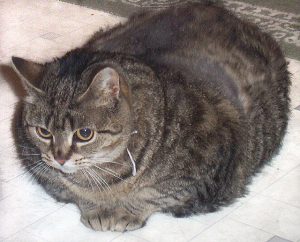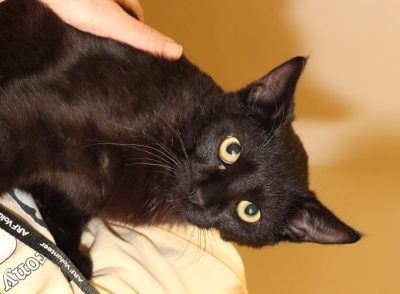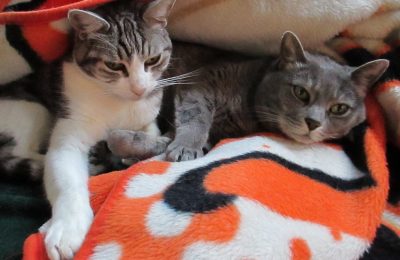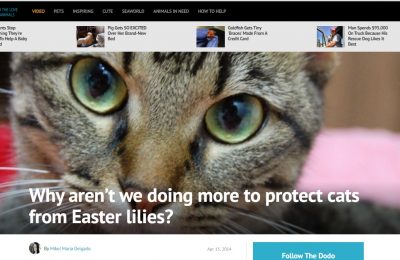Urinary tract problems are relative common in cats – approximately 1.5% of cats who go to the vet are treated for them. But the majority of those problems don’t appear to have a specific cause, so cats are often diagnosed with “feline idiopathic cystitis (FIC)” – the term idiopathic meaning that disease process is of unknown origin. I’ve previously reported on the link between stress and litterbox issues in cats; and the relationship between cystitis and stress in humans and cats appears to be a strong one. But what might cause sthttp://catsandsquirrels.com/whats-stress-got-to-do-with-it/resses in cats that would lead to urinary tract disease?
A new study from Norway, “Risk factors for idiopathic cystitis in Norwegian cats: a matched case-control study” sought to find out what type of environmental or personality characteristics might put cats at risk for FIC. The authors surveyed 70 folks whose cats had been diagnosed with FIC and as a control, surveyed 95 cat owners whose cats were patients at the same veterinary hospital, but had never shown signs of urinary tract problems. Owners were asked several questions about the cat’s environment, personality, how the litterbox and food/water stations were maintained, and the cat’s opportunities to express species-specific behaviors (such as scratching, play, and perching up high). Seventy-one percent of the FIC cats were males, and most were domestic short-haired cats.

Cat-related factors that appeared to be related to an FIC diagnosis included obesity or being overweight (51% of the FIC cats compared to 32% of controls), and fearfulness (36% of the cats with FIC compared to 24% of controls). The only contributing household variable was being kept indoors only, which increased the likelihood of being diagnosed with FIC. Fights with cats outside (or even just the presence of cats outside) did not appear to be a factor.
In addition to weight being a factor, how cats were fed was different between the FIC and control groups, with more FIC cats being on a scheduled feeding regimen, instead of being free fed. There was a tendency for FIC cats to have food and water dishes and litterboxes in less “safe or comfortable” areas. The authors concluded that obesity (and the likely lack of exercise that accompanies it) may have indirect effects on stress. Meal feeding may also be a source of stress, as it may force cats to eat in proximity of other cats, and at a schedule that does not reflect their natural hunting schedules (which would likely include several small meals throughout the day).

I’m always interested in what these studies reveal about how people meet the needs of their cats (regardless of the original research question). Large numbers of cats in both groups showed nervous or fearful behavior. Why? Is this because of a chaotic environment, lack of appropriate safety, poor socialization, or something else? One-third to one-half of cats in the study were reported as overweight or obese! Around twenty-five percent of cats fight regularly with neighboring cats, and around sixteen percent of all cats in the study are often injured from these fights. These reports suggest a sub-optimal social environment for many cats.
How about the physical environment? Around 16 percent of owners in the study placed the food and water dishes in the same location of the litterbox (do YOU want to eat in your bathroom?). Sixty percent of owners cleaned the food and water bowls regularly, but only around half of all cat owners in the study scooped the litterbox daily. Fewer than five percent of owners provided the recommended number of litterboxes (one per cat plus one) in their home. The good news is that over 90% of cats in the study had a scratching area, and over 85% had some type of climbing structure or elevated “vantage point.” Around 65% of cats in both the FIC and control groups were reported as having high levels of playful activity.
So, this study provides us with some insight on potential contributors to FIC in cats, as well as a snapshot of the life of a Norwegian kitty. I think there is always room for improvement in making cats happier when they are stuck living with us – whether that means more mental stimulation, exercise, cat-related resources, or owner education. I think that Norwegian pet owners are probably not so different from their counterparts in other countries, meaning that we might have quite a few scared, fat, stressed-out kitties living in homes throughout the world. And until that changes, my work isn’t done!
Reference
, , , , , and Risk factors for idiopathic cystitis in Norwegian cats: a matched case-control studyJournal of Feline Medicine and Surgery 1098612X15587955, first published on May 27, 2015doi:10.1177/1098612X15587955



Very interesting study coming out of Norway! It’s true – we do have a lot of overweight/obese cats in the US. In addition to weight issues being a factor in urinary tract problems, I wonder how much stress, fear, and anxiety contribute to weight issues themselves? Any way you slice it though, there are lot of ways that cat guardians can reduce stress and fear by enriching their cats’ environments, in addition to maintaining healthy weights. Thanks for sharing your views on this – I always like reading your summary of the papers and studies that come out! – marci 🙂
Marci,
I agree, these factors are all interrelated – stressed cats may spend more time hiding, less time playing! Not to mention the impact stress hormones might have on metabolism. And thanks for reading!
Great that you stress the importance of the litterbox and whether the needs of the cats are met. As you mention, only half of the owners scoope daily, less then 5% had the required number of litterboxes.
Of course indoor-only cats have more problems with FIC: they can’t choose to go outside to relieve themselves. A dirty litterbox and the need ‘to go’ are a horrible combination. No wonder these cats are stressed. Is stress the cause of the problem or the result?
I often see in my practice that once the litterbox issue is resolved, the stress is reduced significantly. No diet or medication needed, just a species-appropriate living environment.
Thanks for sharing your views!
Liesbeth, agreed! A proper litterbox setup can make a world of difference! Thank you for reading!
Very interesting. Regarding the difference between sceduled and free fed cats, a recent study apoints in the same way, linking free feeding and a high water content of the food to additionally drinking more water. Which turns out to be good to prevent urinary and kindey problems. http://www.mimiga.es/2015/06/06/3-studies-that-help-to-improve-your-cat-s-health/